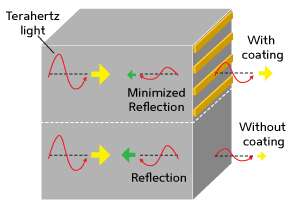Improving terahertz optics with efficient broadband antireflection coatings

Antireflection coatings are familiar from their use in everyday optical devices, such as glasses and lenses. They can increase the amount of light that passes through optical instruments by reducing the fraction of light reflected (and hence lost) at surfaces. Antireflection coatings have applications beyond visible light: for instance, in the infrared and terahertz regimes they are useful for chemical sensing and imaging applications, such as those employed at airport security checks.
Now, Jing Hua Teng from the A*STAR Institute of Materials Research and Engineering and colleagues from the A*STAR Institute of Microelectronics and Osaka University, Japan, have developed ultrathin antireflection coatings for terahertz waves that can be applied to almost any surface. "Their fabrication is very straightforward, as it takes only one step of photolithography, metal deposition and lift-off," explains Teng.
Antireflection coatings are usually based on interference effects, which requires them to be at least as thick as the wavelength of light. This is practical for visible light, with wavelengths in the range of hundreds of nanometers. However, it is a serious limitation for infrared or terahertz radiation, which has much longer wavelengths of the order of hundreds of microns. Moreover, as these coatings are often functional only over narrow frequency ranges, they do not operate across the broad ranges needed for terahertz sensing applications.
The research team developed antireflection coatings based on metamaterials, which are metallic structures that are much smaller than the wavelength used. These structures completely alter the optical properties of a material in a predetermined way, enabling the generation of a much broader range of optical effects than those that occur naturally. One application of the unusual optical effects they produce is invisibility cloaks.
In the new design for metamaterial surfaces developed by the researchers, thin strips of chromium are fabricated on a silicon surface to form a grating (see image). Silicon, being flexible, is a typical material for terahertz optics. When terahertz light passes through the stripes and into the silicon, its phase is changed in the same way as for the much thicker coatings based on interference effects; this suppresses surface reflection.
These metasurfaces have the advantage that they can function across an unprecedentedly wide frequency range, namely 0.06 to 3 terahertz. The flexibility of the coatings for other wavelengths and applications also enhances their commercial appeal, comments Teng. "The beauty of this method is that it is very flexible and can be easily adapted to other metals and substrates."
More information: Ding, L., Wu, Q. Y. S., Song, J. F., Serita, K., Tonouchi, M. & Teng, J. H. "Perfect broadband terahertz antireflection by deep-subwavelength, thin, lamellar metallic gratings." Advanced Optical Materials 1, 910–914 (2013). dx.doi.org/10.1002/adom.201300321
Journal information: Advanced Optical Materials


















